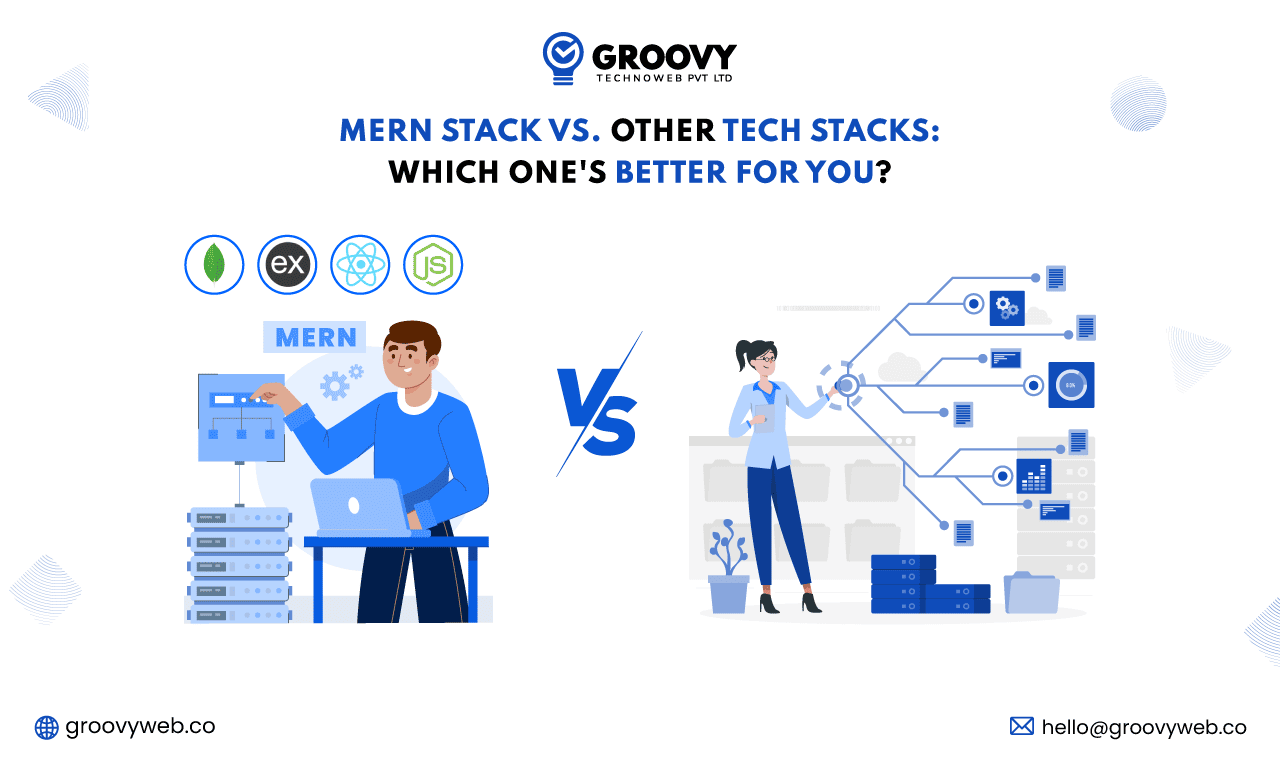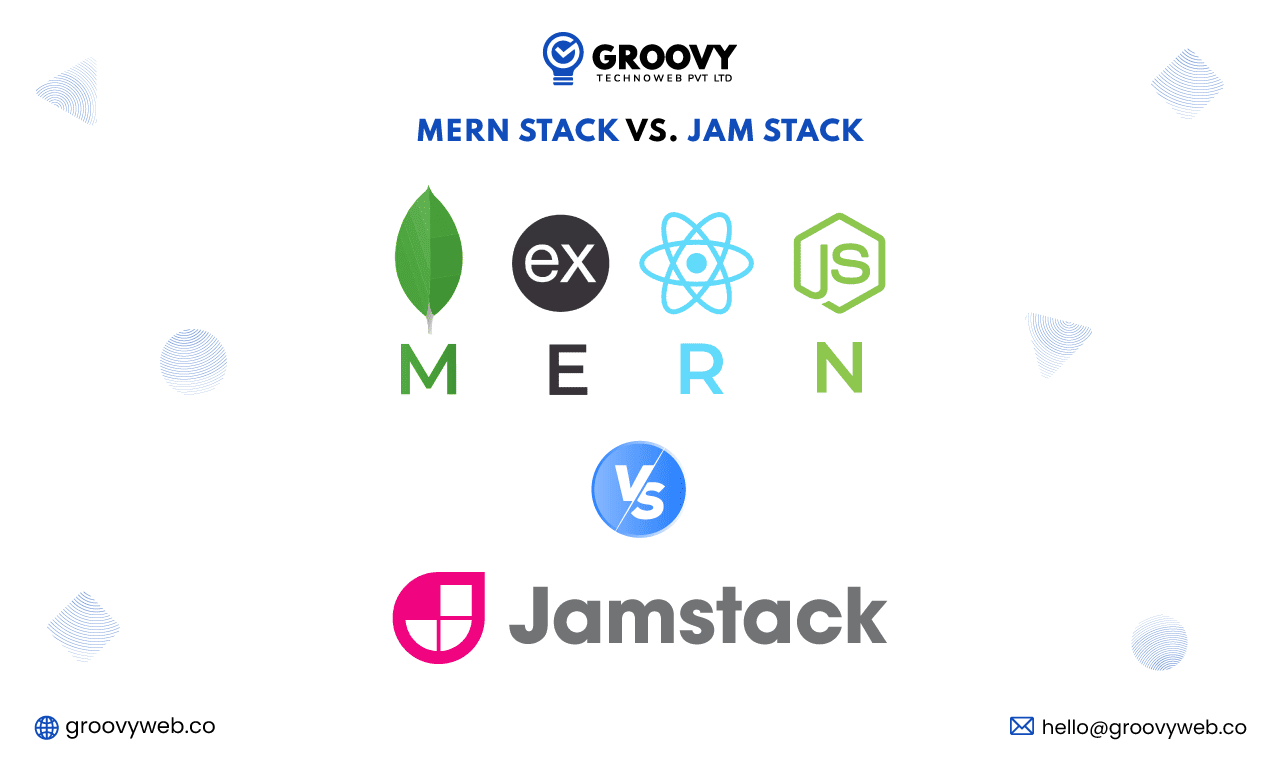MERN Stack and Other Tech Adoption: Which is your Best Fit
Sagar Patel
October 16, 2024 242 Views
Quick Summary : In the rapidly evolving tech landscape, choosing the right stack for your project is crucial. This article explores the MERN stack—MongoDB, Express.js, React.js, and Node.js—highlighting its advantages in creating dynamic, full-stack applications. Additionally, we delve into other tech options, comparing features, scalability, and community support to help you determine the best fit for your specific needs. Discover which technology aligns with your goals and enhances your development process.
Selecting appropriate stacks above others for a particular web project is fundamental for success in web development as it is an ever-changing field. With so many variables to accommodate, the technology stack developers or project managers selected dramatically affects the project’s result. One of those options that has become extremely popular is MERN. This article explores the MERN stack and compares it with other tech stacks to help you choose the best fit for your app. The MERN stack is still in business. What competition does it have to face? Let’s dig deeper.
What is the MERN Stack?
The MERN stack is a super cool combination of technologies used to design dynamic and robust web applications. It contains:-
- MongoDB: NoSQL database storing data in JSON-like documents. Great for versatility and scalability.
- Express.js: Lightweight and flexible Node.js web application framework that can help make APIs incredibly powerful.
- React.js: A JavaScript popularized by Facebook, React.js aims to provide solutions for user interface development, especially for single-page applications.
- Node.js is a Javascript server-reliant environment built on top of Google Chrome’s V8 Javascript engine. It allows for executing Javascript codes on the server side.
Development Process
In the MERN tech stack, the JavaScript code can control both the front and back end.
Advantages of MERN Stack
JavaScript from Front End to Back End
It also offers the complete development lifecycle with the support of JavaScript. This is thus not hard to learn or master as one does not need to acquire knowledge of many languages; on the other hand, it makes developers rely upon JavaScript from the client side to the server side. Moreover, it makes accessible communication and debugging less complicated because JavaScript runs on both the client and server sides.
Efficient and Scalable
MERN tech stack is highly scalable and very efficient. MongoDB is a NoSQL database. Applications with growing data demands can use it because it provides horizontal scaling. The performance of React js is enhanced due to the presence of a virtual DOM, as the operations on the actual DOM are reduced. Due to event-driven architecture, operations in Node.js do not block, making them faster and more efficient on the server side.
Amazing Community Support
Developers nurture the MERN stack by constantly improving it. An active community will ensure that many resources, libraries, and tools are available for faster development and to fix potential problems, therefore getting ready for deployment in no time. Not only does this maintain up-to-date relevance, but the industry also sets the latest standards with regular updates and improvements to the stack.
Agile and Customization-friendly
By nature, the MERN stack is a modular system. Every piece is easy to replace or expand, as needed, for any project. For example, other databases and frameworks can be used while retaining all the stack’s core strengths. This capability allows solutions to fit the best needs of a particular project.
Performance and Speed
Web applications using the MERN stack can very well meet the requirement of high performance, as its nature is asynchronous, non-blocking I/O operations. That means any requests can be handled simultaneously without losing speed. This led to a responsive user experience and faster interaction with the application, which requires real-time interaction.
Fast Development
In development, the MERN tech stack has streamlined things using rapid prototyping and time-to-market. Its component-based architecture promotes the principles of modularity with code reusability that indeed builds very complex user interfaces in relatively more straightforward ways with developers. Creating robust APIs becomes easier through Express.js in a much more manageable time with which one can easily set up server-side logic.
MERN Stack and Its Competitiveness with Other Tech Stacks
Despite the numerous benefits of the MERN stack, it is prudent to assess the alternative popular tech stacks to know which one is best suited for your project. The following passage will seek to contrast the MERN technology stack with the MEAN, LAMP, and JAM stack.
MERN Stack vs. MEAN Stack
MEAN Stack differs from the MERN Stack in its front-end framework. While React.js is used for the MEAN Stack, the other well-known JavaScript framework developed by Google is Angular.js.
Advantages of MEAN Stack:
- Two-way data binding: Angular.js supports two-way data binding. Thus, it automatically aligns the data between the model and view to reduce boilerplate code.
- Strong Typing: Angular is based on TypeScript, which is statically a superset of JavaScript. Hence, you can catch all errors early in the development process and improve the quality of your code.
- Completeness Framework: Angular.js is a complete framework with some inbuilt dependencies associated with features such as dependency injection, routing, state management, etc., so you get a more structured approach to your development process.
Benefits of MERN Stack
- Virtual DOM: React.js uses the virtual DOM, which would significantly improve performance as there are fewer direct manipulations of the actual DOM.
- Component-Based Architecture: This component-based architecture enables the easy use of React for vast, complex user interfaces.
It is flexible as it limits its scope only to the view layer and allows it to use any other libraries or frameworks thought and decided for handling various spectrums of an application.
Comparison of MERN Stack and LAMP Stack
The LAMP stack is part of the so-called first-generation stack, composed of Linux, Apache, MySQL, and PHP. For ages, this mixture has been a go-to solution for many web development tasks.
LAMP Stack advantages
- A Comprehensive Environment: A well matured and balanced environment exists in the case of LAMP, where lots of resources, documentation, and support from the community are available.
- Cost-Effective: All the components of the LAMP stack are open-source and hence can be availed of by anyone willing to do so. This will cut down quite a number of the project costs significantly.
- Server-Side Rendering: With the use of PHP and MySQL, the two can render quite well on the server side, and thus, this may have a good influence on SEO and the loading speed of the first page.
Benefits of MERN Stack:
- Single Language Development: MERN tech stack uses JavaScript for both your front-end and back-end development, allowing you to follow a single language throughout the development process and reducing context switching.
- Scalability: MongoDB is a NoSQL database with higher scalability than traditional relational databases like MySQL, making it ideal for high-growing data applications.
The MERN stack follows modern development practices with component-based architecture, asynchronous programming, and microservices, improving the development workflow and application performance.
MERN Stack vs. JAM Stack

JAMstack is an advanced web design model that uses Javascript, APIs, and markup languages. It assists in loosening up the underlying architecture by separating the front end from the back end, thereby ensuring that a higher focus is put on the speed, security, and scalability of the applications in question.
Benefits of JAM Stack
- Performance: Serving pre-rendered static content from a CDN provides superb performance and load times for sites on the JAM stack.
- Security: Decoupling the front end from the back end reduces the attack surface, improving security.
- Scalability: Sites on JAMstack scale very quickly globally through CDNs; it also ensures fast load times for users across the globe.
Benefits of MERN Stack
- MERN tech stack is better suited for developing dynamic, interactive applications that demand real-time updation and complex interaction from the user interface.
- Node.js and Express.js provide full control over the back-end logic, thus giving complete customization and flexibility.
- A gigantic ecosystem of libraries, tools, and frameworks in the MERN stack can enhance development efficiency or add extra functionality.
When to Use MERN Stack
The MERN stack can be used for various web development projects. However, only some projects can be handled with the stack because it is efficient and fast. There are certain circumstances under which The MERN stack performs above average. These are:
Single Page Applications (SPAs).
It makes MERN stand for the applications that insist on high-speed and responsive user interfaces. React.js stands out mainly because it allows for a dynamic and interactive user interface through its virtual DOM and component-based architecture. Applications of the MERN tech stack load a single HTML page; therefore, updating content on the screen will not require refreshing the whole page and would be very smooth for the user.
Real-Time Applications
According to the MERN tech stack, applications can include all live streaming applications, chat applications, collaborative tools, or any other application. The event-driven architecture of the Node.js platform and its capability to support Web-sockets enable real-time communication. In addition, the developer can build capabilities like live notifications, messaging, and real-time data sync into the application that make a user’s life much easier.
Full Stack JavaScript Development
This is particularly useful if you must rely on JavaScript throughout development. In this regard, consistency thus fosters easy code sharing, cooperation, and a very fluid development flow. Developers may then apply their JavaScript knowledge, both front-end and back-end, thereby reducing the requirement for multi-language expertise.
Scalable and Flexible Applications
The MERN stack is a favorite app that presents large data streams. MongoDB, because it is a document store, allows schema design to be flexible and supports horizontal scaling, which makes MongoDB very scalable with applications. As it’s modular, the stack can be replaced or added components as needed by developers; they can swap in or add new components depending on need, which is flexibility and adaptability to the needs of a project.
Prototyping and MVP Development
MERN tech stack is so excellent for rapid prototyping that it could even be utilized in development for a Minimum Viable Product. The features why developers can prototype and, therefore, make MVPs with impressive speed include efficient server-side processing by Node.js and reusable components of React.js. Willingness to change and improve according to users’ thoughts has made building MVPs easier and faster while spending fewer days in the market, significantly reducing the cost of building a web application.
So, when should a different tech stack be chosen?
Remember, even with the diversity and might of the MERN stack, there remain specific scenarios in which other tech stacks would be more appropriate. Here are some scenarios in which you may want to use others:
Legacy Web Applications
The LAMP stack is more geared toward legacy web applications, which still need server-side rendering and SEO optimization. PHP and MySQL offer excellent server-side processing. Moreover, its old and well-documented ecosystem gives solid reasons for projects requiring stability and reliability.
The requirements for typing are vital for more complex applications such as enterprise scale and more elaborate frameworks, and the structure is even more severe. Again, the MEAN stack is helpful, considering that Angular.js uses TypeScript and its extra features: dependency injection and routing. Static typing in TypeScript leads to early-stage bug removal and improves quality and maintainability. So, this opinionated framework for Angular is perfect for big projects: it gives developers a clear and structured way of developing big complex applications.
Static Sites and Content-Driven Apps
For applications where performance and security become a matter of concern, like static sites and content-driven apps, JAMstack fits perfectly. Due to the pre-rendered static content and serving through a CDN, JAMstack-based sites can have superior load times and enhanced security. Interestingly, this architecture is best suited for applications like blogs, marketing websites, and documentation sites where load times must be fast and scalable.
Data-Intensive Applications
Other applications might natively use a relational database like MySQL or PostgreSQL, the core component of the LAMP stack. Relational databases are ideal for structured data, ‘ chained together,’ complex relationships, and ACID transactions. Suitable for applications that need outstanding complex data requirements, query power, and data integrity.
High Traffic Applications
This could be done for the tech stacks through server-side rendering and caching mechanisms. Even when mature and well-optimized server software in the LAMP stack is considered, it can efficiently handle the applications when developed, keeping in mind low latency response time-demanding applications. Techniques like Varnish Cache or Memcached for server-side caching considerably reduce the response times and decrease the load on the server.
Conclusion
It’s such a deep dependency in terms of a tech stack built regarding many aspects: the project’s needs, scalability issues, and many more. The MERN benefits include having full-stack framework JavaScript development, scaling, and a robust community for development purposes. It would be an excellent choice for dynamic and interactive web applications.
However, other tech stacks are chosen with an eye to the specific project requirement. For example, the MEAN stack suits some kinds of applications alongside LAMP, JAMstack, etc. A holistic evaluation of the requirements and goals of a project can be made to make a rational choice about whether or not one needs the MERN tech stack.
The final answer is quite sensitive to each technology stack’s best strengths and capabilities and what can be done to build efficient, scalable, high-performance applications. The real solution comes down to meeting your needs for the project and delivering the best possible user experience to end-users, whether it’s MERN stack or another tech stack.
Written by: Sagar Patel
Sagar Patel is the CTO and Co-founder of Groovy Web. He was involved in the telecommunications & Automation industry during his early career. Still, due to his attitude toward learning anything new and mastering it, he now works as a CTO for Groovy Web. Through their business mindset and logical approach, they have taken their company to the next level; His responsibilities now include all aspects of the business. Among them are finance, process design, and development.
Frequently Asked Questions
We hope these clear your doubts, but if you still have any questions, then feel free to write us on hello@groovyweb.coHow does the MERN stack compare to other full-stack technologies?
MERN is popular due to its streamlined development process, particularly in JavaScript. However, other stacks like MEAN (Angular instead of React) or LAMP (Linux, Apache, MySQL, PHP) have advantages like SEO-friendliness and server-side rendering. The best stack depends on your project needs and existing expertise.
What are the benefits of adopting MERN for web application development?
MERN enables fast, scalable development. It uses React for a flexible front-end, allowing for component-based architecture, and Node.js for handling asynchronous, non-blocking server operations. This stack is particularly beneficial if you need real-time or single-page applications (SPAs)
How do I know if MERN is the best tech stack for my project?
Choosing MERN depends on your project goals. MERN might be the best fit if you prefer a JavaScript-based solution, need fast and scalable development, and prioritize flexibility in your front end. However, assess your project’s database needs, real-time functionality, and developer familiarity with the stack.
What are some alternatives to MERN for tech adoption, and when should I consider them?
Alternatives like MEAN, JAMstack, or LAMP may be better depending on your project’s focus. MEAN suits enterprises needing strict structure, JAMstack excels in static site generation for better performance, and LAMP is a well-established stack for traditional web apps. Evaluate your project’s scope and developer expertise before deciding.
Related Blog

Ashok Sachdev
How Are Chatbots In Restaurants Redefining Customer Experience In 2023
Chatbot Development 13 Nov 2024 9 min read
Krunal Panchal
All You Need to Know About Healthcare App Development
Healthcare 09 Apr 2025 11 min read
Ashok Sachdev
Essential Guide For Chrome Extension Development in 2023
Web App Development 12 Jan 2023 12 min readSign up for the free Newsletter
For exclusive strategies not found on the blog